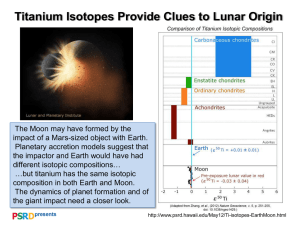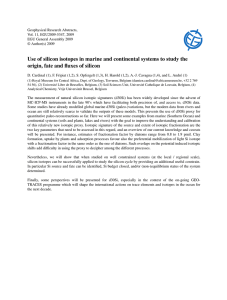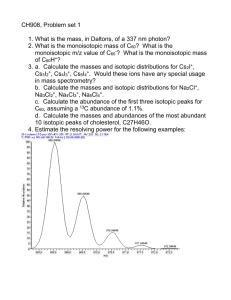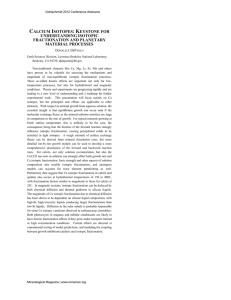SK Bhattacharya* and MH Thiemens Department of
advertisement
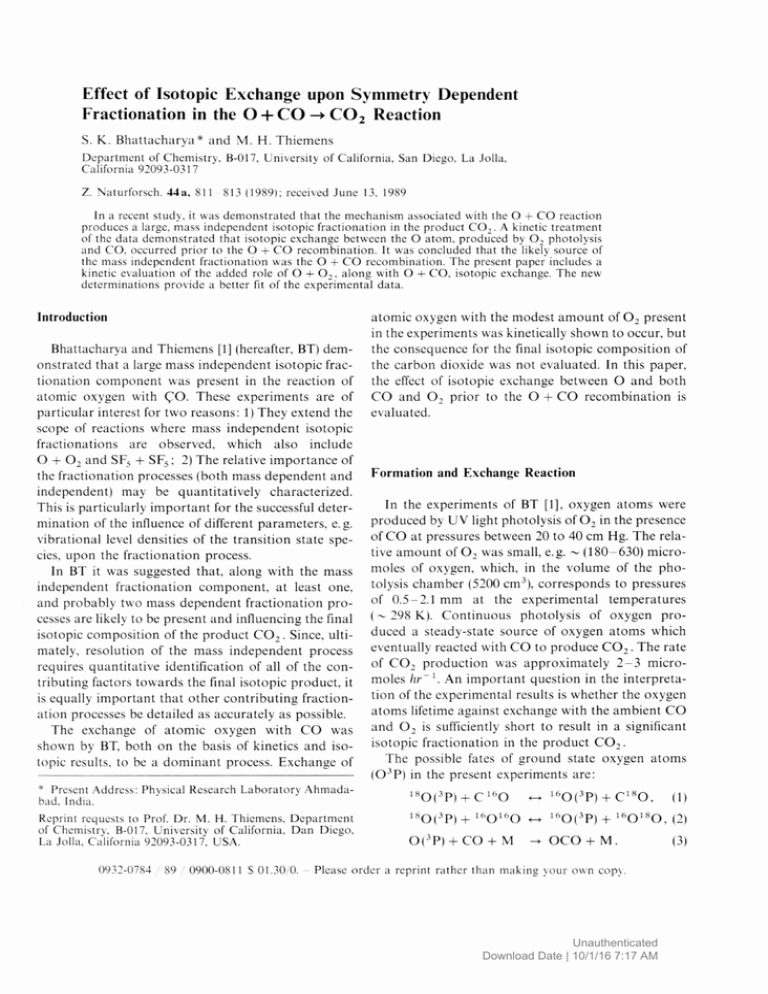
E ffe c t o f I s o to p ic E x c h a n g e u p o n S y m m e try D e p e n d e n t F r a c tio n a tio n in th e O + C O C 0 2 R e a c tio n S. K. Bhattacharya* and M. H. Thiemens Department of Chemistry. B-017, University of California. San Diego, La Jolla, California 92093-0317 Z. Naturforsch. 44a, 811 813 (1989); received June 13. 1989 In a recent study, it was demonstrated that the mechanism associated with the O + CO reaction produces a large, mass independent isotopic fractionation in the product CO,. A kinetic treatment of the data demonstrated that isotopic exchange between the O atom, produced by O, photolysis and CO. occurred prior to the O + CO recombination. It was concluded that the likely source of the mass independent fractionation was the O -I- CO recombination. The present paper includes a kinetic evaluation of the added role of O -I- 0 2, along with O -I- CO, isotopic exchange. The new determinations provide a better fit of the experimental data. Introduction Bhattacharya and Thiemens [1] (hereafter, BT) dem­ onstrated that a large mass independent isotopic frac­ tionation component was present in the reaction of atomic oxygen with £ 0 . These experiments are of particular interest for two reasons; 1) They extend the scope of reactions where mass independent isotopic fractionations are observed, which also include O + 0 2 and SF5 + SF5; 2) The relative importance of the fractionation processes (both mass dependent and independent) may be quantitatively characterized. This is particularly important for the successful deter­ mination of the influence of different parameters, e.g. vibrational level densities of the transition state spe­ cies, upon the fractionation process. In BT it was suggested that, along with the mass independent fractionation component, at least one, and probably two mass dependent fractionation pro­ cesses are likely to be present and influencing the final isotopic composition of the product C 0 2. Since, ulti­ mately, resolution of the mass independent process requires quantitative identification of all of the con­ tributing factors towards the final isotopic product, it is equally important that other contributing fraction­ ation processes be detailed as accurately as possible. The exchange of atomic oxygen with CO was shown by BT, both on the basis of kinetics and iso­ topic results, to be a dominant process. Exchange of * Present Address: Physical Research Laboratory Ahmadabad. India. Reprint requests to Prof. Dr. M. H. Thiemens. Department of Chemistry, B-017, University of California, Dan Dieao, La Jolla, California 92093-0317, USA. 0932-0784 / 89 /0800-825 S 01.30/0. atomic oxygen with the modest amount of 0 2 present in the experiments was kinetically shown to occur, but the consequence for the final isotopic composition of the carbon dioxide was not evaluated. In this paper, the effect of isotopie exchange between O and both CO and 0 2 prior to the O + CO recombination is evaluated. Formation and Exchange Reaction In the experiments of BT [1], oxygen atoms were produced by UV light photolysis of 0 2 in the presence of CO at pressures between 20 to 40 cm Hg. The rela­ tive amount of 0 2 was small, e.g. ~ (180-630) micromoles of oxygen, which, in the volume of the pho­ tolysis chamber (5200 cm3), corresponds to pressures of 0.5-2.1 mm at the experimental temperatures ( ~ 298 K). Continuous photolysis of oxygen pro­ duced a steady-state source of oxygen atoms which eventually reacted with CO to produce C O ,. The rate of C 0 2 production was approximately 2-3 micromoles hr~l. An important question in the interpreta­ tion of the experimental results is whether the oxygen atoms lifetime against exchange with the ambient CO and 0 2 is sufficiently short to result in a significant isotopic fractionation in the product C 0 2. The possible fates of ground state oxygen atoms ( 0 3P) in the present experiments are: 180 ( 3P) + C 160 <-> 160 ( 3P) + C 180 , (1) is0 (3P)+ 160 160 160 ( 3P) + 160 180 , (2) 0 ( 3P) + CO + M OCO + M . -Please order a reprint rather than making your own copy. Unauthenticated Download Date | 10/1/16 7:17 AM (3) 812 S. K. Bhattacharya and M. H. Thiemens The rate constants for the reactions are: kl = 8.3 x 10"16 cm3 molec - 1 s_1, k2 = 2.9 x IO"12 cm3 molec"1 s " 1, k3 = 3.9 x 10"36 cm6 m olec'2 s_1 (references [2-4], respectively). For the experiments of BT, the rate of the iso­ tope exchange of O with CO is faster than the O + CO 4- M recombination. For example, for a CO pressure of 20 cm the ratio of the rates of O —CO isotope exchange to recombination is simply: kx[O] [CO]/*3 [O] [CO] [M] % 33, with M, in this case, CO. The exchange of atomic oxygen with 0 2 is faster yet, as may be seen by comparison of the rate of reactions (2) and (1). That ratio, R, is given by R = k2[0 ][ 0 2]/kl [0][C0] or (4) R - 3.5 x 103[O2]/O2[CO], For the experiments of BT, 8 < R <20. The evaluation of the two isotope exchange rates, compared to the rate of the O —CO recombination, demonstrates that the isotopic composition of the ox­ ygen atoms is dynamically determined by the two exchange processes immediately subsequent to forma­ tion of the atoms by 0 2 photolysis. This exchangemodified O-atom reservoir has the relevant isotopic composition for determining the fractionation which is ascribed to the O + CO + M step. Consequently, the net fractionation induced by the isotope exchange reactions (1) and (2) must be quantitatively evaluated to determine the end-member O-atom composition for reaction (3). where the CO isotopic composition is, of course, known. The photodissociation of 0 2 and subsequent oxy­ gen isotope exchange reactions occur on short time scales. For the calculation of the resulting isotopic composition of O we use a combination of equilib­ rium constants and rate constants. One partner of the exchange reactions being monoatomic, the equilib­ rium constants are given by the reduced partition function ratios of the other, biatomic partner, (cf. Bigeleisen and Mayer [5]; Urey [6]). A recem, r'cfincd evaluation of the reduced partition function CO and 0 2 will be used (Table 12 of [7]). At 25 CC they amount to 1.1064 and 1.077, for CO and 0 2, respecticely [7], These values compare to those of Urey [6] which are 1.1053 and 1.0818. respectively. These values indicate that, at equilibrium, exchange between oxygen atoms and CO produce isotopically fractionated oxygen Isotopic Exchange upon Symmetry Dependent Fractionation atoms 106.4%o lighter in (5180 than the dominant CO reservoir. Similarly, exchange with 0 2 produces oxy­ gen atoms 77.2%o lighter in <5180 than the 0 2 with which it exchanged. In the experiments of BT. the initial isotopic compo­ sitions of CO and 0 2 relative to our standard O, are <5lsO(CO) = 16.1, <5170 (C 0 ) = 8.4; <5180 ( 0 2) = "l8.0, (51 0 ( 0 2) = 9.5. Therefore, the two isotope exchange processes produce oxygen atoms whose isotopic com­ position may be calculated as follows. Assuming that the net effect due to the two ex­ changes may be determined by statistically weighting each exchange according to its rate, the oxygen iso­ topic composition of O is then given by (5lsO(Onet) = (—59.2 R - 90.3)/(K + 1), (5) <5170 (0 n et) = ( - 31.0R - 47.5)/(K + 1). (6) The values of <5lsO(Onet) and <5170 (0 n et) calculated using the various values of R for the BT experiments show only small variations. The mean ^-values from calculations for both 0 2 and CO exchange of the oxygen atom reservoir are <5180 (0 n et) = - 61.7; <5170 (0 n e t) = - 32.4. The oxygen atoms, with the steady state isotopic composition given above, subsequently react with C0(cS180 (C 0 ) = 16.1; (5170 (C 0 ) = 8.4) to form C 0 2 whose composition, in the absence of any isotopic 70 J m- .84 60 - •/ 50| 40 o To 30 20 /• / — m=.52 •, / /• 10 tff&i ;o I l l l i i I I 1 1 40 -30 •20 0 10 20 30 40 50 60 70 60 8180(°/00) 10 BULK -20Fig. 1. The oxygen isotopic composition of CO, produced by reaction of atomic oxygen with carbon monoxide. The bulk isotopic composition is determined from equilibrium exchange between O and both CO and 0 2, and the corre­ sponding reaction rates. Unauthenticated Download Date | 10/1/16 7:17 AM S. K. Bhattacharya and M. H. Thiemens • Isotopic Exchange upon Symmetry Dependent Fractionation fractionation, has the "bulk" value ()180 ( C 0 2 bulk) = - 22.8; <S170 = -12.0. The data of BT are displayed in Fig. 1, along with the new "bulk" point calculated above. In the present work, the data have been fitted with an improved version of the least squares fitting [8], which takes into account the error associated with the individual data points (~±0.1%o for <$180 ( C 0 2) and <S170 ( C 0 2)). The new best fit line has a slope (m) of 0.84 and differs slightly from the one given in Fig. 1 of BT (m = 0.82). The best fit line intersects the mass fractionation line (m = 0.5 (17/16.5)2 = 0.53) at <5180 = - 25.7, <5170 = —13.5, quite close to the calculated bulk point, and more so than for the original calculation of BT. It is quite clear from the foregoing evaluation that oxygen atom isotope exchange with both CO and 0 2 is significant. Although the 0 2 concentration is quite low with respect to CO, the combined rapidity of the O —0 2, and slowness of O —CO exchanges, render it a significant process. Finally, the observation that the data define a straight line, which touches so closely the [1] S. K. Bhattacharya and M. H. Thiemens, Z. Naturforsch, 44 a, 435 (1989). [2] S. Jaffe and F. S. Klein, Trans. Faraday Soc. 62, 3135 (1966). [3] S. M. Anderson, F. S. Klein, and F. Kaufmann, J. Chem. Phys. 83, 1648 (1985) [4] T. G. Slanger, B. J. Wood, and G. Black, J. Chem. Phys. 57, 233 (1972). 813 bulk point calculated for isotopic exchanges, strongly suggests that isotopic exchange equilibria are at­ tained. This also further supports the contention by BT that the source of the mass independent fraction­ ation component is in the actual O + CO recombina­ tion process. Conclusion Formation of C 0 2 by the reaction of O with CO produces a large mass independent isotopic fraction­ ation. A best fit line of the data produces a slope of 0.84 in a <5170 ( C 0 2) vs. c5180 ( C 0 2) plot with an inter­ cept of the mass fractionation line through the origi­ nal CO and 0 2 points, quite close to the "bulk C 0 2" value calculated for the addition of an oxygen atom which has undergone equilibrium isotopic exchange with CO and O, in proportion to their relative rates. Acknowledgements Stu Anderson is thanked for his comments regard­ ing isotopic exchange processes. [5] J. Bigeleisen and M. G. Mayer, J. Chem. Phys. 15, 261 (1947). [6] H. C. Urey, J. Chem. Soc. London 1947, 561. [7] P. Richet, Y. Bottingan, and M. Javoy, Ann. Rev. Earth Planet. Sei. 5, 65 (1977). [8] J. H. Williamson, Can. J. Physics 46, 1845 (1968). Unauthenticated Download Date | 10/1/16 7:17 AM
